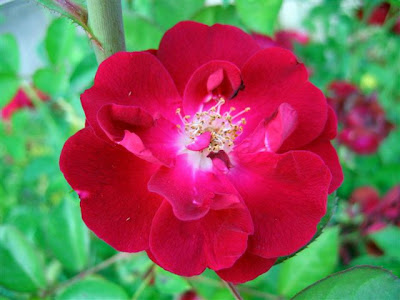 I will start the rose line up with a wild pink shrub Rose I am very fond of. This shrub is huge and round, about 18 ft wide. When my daughter was young, we picked hundreds of the buds to use for crafts. I love it's scent and free flowering lushness in June, and the shape looks good in the landscape the rest of the year, as well.
I will start the rose line up with a wild pink shrub Rose I am very fond of. This shrub is huge and round, about 18 ft wide. When my daughter was young, we picked hundreds of the buds to use for crafts. I love it's scent and free flowering lushness in June, and the shape looks good in the landscape the rest of the year, as well. My only yellow rose is GrahamThomas , a David Austin English rose. It is a beauty, and has a lovely fragrance. It was the last rose in bloom for me, when we received our first snowfall of 2007.
My only yellow rose is GrahamThomas , a David Austin English rose. It is a beauty, and has a lovely fragrance. It was the last rose in bloom for me, when we received our first snowfall of 2007. Graham Thomas is not only pretty on the bush, but makes a wonderful bouquet. Featured here on a very old Hardanger table scarf my Mother gave me. It was made by someone in our family tree many, many years ago. Note that I have roses on my walls, too. ;-)
Graham Thomas is not only pretty on the bush, but makes a wonderful bouquet. Featured here on a very old Hardanger table scarf my Mother gave me. It was made by someone in our family tree many, many years ago. Note that I have roses on my walls, too. ;-)[Rachel, this is for you, since I know how fond you are of this one. Only wish I could send you the sweet fragrance, as well! :-) I have missed your garden visits.]
 This wild red rambler, most likely a rugosa, came up from the roots of a hybrid tea rose that died. It grows tall and lanky, and can get rather messy. I always say I am going to cut it down, but then when it blooms in June, it wins me over once again.
This wild red rambler, most likely a rugosa, came up from the roots of a hybrid tea rose that died. It grows tall and lanky, and can get rather messy. I always say I am going to cut it down, but then when it blooms in June, it wins me over once again.Update: A reader has identified this as the climbing rose "Dr. Huey", one of the most common root stocks.
 Pink Simplicity hedge roses, growing inside the picket fence, are the backbone of my cottage garden. There are ten on each side of the garden, separated by the center walk. This photo was taken in the evening just before sunset.... so the flowers really look like they are glowing.
Pink Simplicity hedge roses, growing inside the picket fence, are the backbone of my cottage garden. There are ten on each side of the garden, separated by the center walk. This photo was taken in the evening just before sunset.... so the flowers really look like they are glowing. A close up of Pink Simplicity. They are so pretty and bloom their hearts out, but alas, have no fragrance. They are also prone to blackspot. Jackson & Perkins now has a Lavender Simplicity with fragrance and disease resistance, which I would like to try somewhere in my garden.
A close up of Pink Simplicity. They are so pretty and bloom their hearts out, but alas, have no fragrance. They are also prone to blackspot. Jackson & Perkins now has a Lavender Simplicity with fragrance and disease resistance, which I would like to try somewhere in my garden. This is an old classic rose of the Alba clan, named Konigin von Danemark (Queen of Denmark). I love the fullness of the quartered petals and the sweet Damask scent. It is very hardy and disease resistant.
This is an old classic rose of the Alba clan, named Konigin von Danemark (Queen of Denmark). I love the fullness of the quartered petals and the sweet Damask scent. It is very hardy and disease resistant. And lastly, the humble wild roses that grow along the roadsides here. They have a special place in my heart, because they remind of the the Wild Prairie Rose, the state flower of North Dakota, where I grew up. Last year we had to be assigned physical addresses, instead of our rural route and box numbers. My submission of a name for our road was the winner, so we now enjoy living on Wild Rose Lane.....and I just love the sound of it. :-)
And lastly, the humble wild roses that grow along the roadsides here. They have a special place in my heart, because they remind of the the Wild Prairie Rose, the state flower of North Dakota, where I grew up. Last year we had to be assigned physical addresses, instead of our rural route and box numbers. My submission of a name for our road was the winner, so we now enjoy living on Wild Rose Lane.....and I just love the sound of it. :-)~~~~~~~~~~~~~~~~~~~~~~~~~~~~~~~~~~~
"I'd rather have roses on my table than diamonds on my neck." ~Emma Goldman














